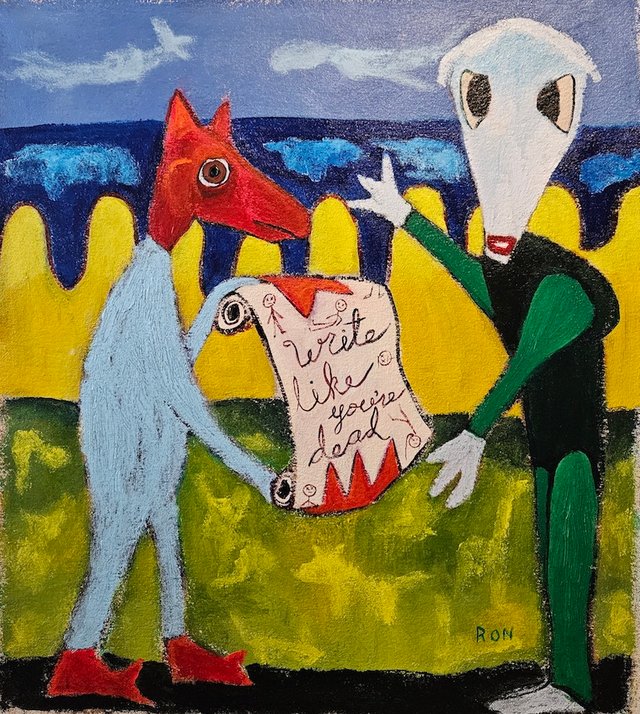Just Another Literary Stuckist

Advice for Living Authors 2024. Acrylic on loose canvas, 20 x 23"
I am working on my new book, Making Friends With Wild Dogs. Here is a brief, rough draft excerpt, for your eyes only:
Everything that I have written seems like straw compared to those things that I have seen and have been revealed to me.
—Thomas Aquinas, a single, solitary, boring, non-toilet-flushing Homo sapien of the 105 billion who have lived on earth since 50,000 B.C.E.
Most adult art is made by mentally ill people. I’m talking about serious art, or rather, art made by people who take their art seriously, even the silly crazy artists. The retirees at the local art center are long past the agonies of failure and neurosis. They’ve given up the ghost a grandchild or two ago, and will love Netflix® to death, eventually. Making art is their affordable social play time because not even the highest pensioner can afford to go out to dinner every single night.
Obviously, people don’t need art as a commodity to acquire. That too is a symptom of the disease. Children make art for the pleasure of being the cause. That is art process, art giving, and where art should have plateaued. There is nature, and art-making to praise it, which can make humans appear more interesting and introspective that the rest of life because of our funky thumbs. Unfortunately, not long after the invention of photography, art became a practice for any expressive person (not just the talented renderers), and an avenue toward self-actualization. The real broken painters took it a step further, commoditizing their process to build a name for themselves. Art business for business sake—rather than art commissioned by rich merchants and landowners to paint their family portraits. Any man at the time could become “artist”, even if he was absent-mindedly drawing geometric shapes and coloring them in. No longer was the painter just another “job for hire”, like in olden times, when the gifted and trained could find employment as an interior decorator for the wealthy. The latter were never keen on art for art’s sake. Expressive success was for the clowns. Art was a serious profession.
Until the Industrial Revolution and ensuing population boom, gave art its circus tent performances.
End of 19th century lottery winners such as Paul Gauguin could simmer beans and paint topless ladies under palm trees for little monetary reward, yet gain a lifetime of self-respect. If at times he felt poor and dejected, he could always take comfort that, as a singular arteest gaining fame, his progeny would be taken care of. Art celebrity became a thing, and soon, museums made a modern painter’s life as remarkable as his canvases. Likewise, gallerists (art brokers) got hold of their own “Gauguins” to hawk among the super rich.
But we must accept that Gauguin was very sick, like any modern artist, and used painting to engorge the ego. In his time, the concept of self and the individual was epidemic. There were millions of “mes” coming in and out of the world. Life was becoming less difficult. Upward mobility could come even to a poor painter struggling with self-identity. The growing middle class wanted to feed their egos too. Everyone wanted something new. Even those who couldn’t afford it.
Enter the next 100 years of art celebrity and the inevitability of reform, which is Stuckism. Then watch it warp into the thing it once wanted to destroy. No different from the initial innocent demands of Christian Protestantism and the eventual violent jingoism of a Billy Graham cracker. Painter Joe machine says he’s a Stuckist, and his canvases are hanging at Gatwick airport. It takes 25 years for a movement to get saturated with its own vomit. I don’t think the original Stuckists learned very much after all. You just can’t annihilate the ego while pining for success. You can’t become a sole proprietorship seeking enlightenment.
Maybe I should destroy Stuckism and create a new movement instead.”